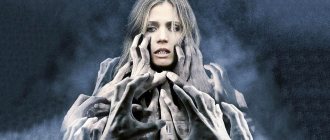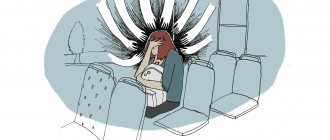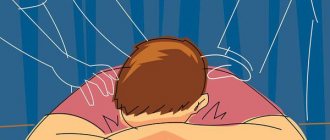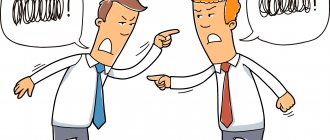Medical information is reliable Checked by Eremin Alexey Valentinovich
Acute psychotic disorder belongs to the group of transient psychoses. They are characterized by manifestations in the form of delusions, affective deviations, disorganization of thinking, hallucinations, mood disorders and other symptoms. It begins suddenly, there is no prodromal period. Recovery occurs after a few days or months. This pathological condition is most often observed in women, which distinguishes it from schizophrenia, in which the likelihood of its occurrence does not depend on gender.
Causes of acute psychotic disorder
The main reason for the development of acute psychotic disorder is severe psychotrauma, that is, a situation that is perceived by a person as severe stress:
- death of a loved one;
- divorce;
- job loss;
- car accident;
- stay in a war zone;
- physical or mental violence;
- long stay in a mentally aggressive environment;
- loss of money;
- economic difficulties.
Provoking factors contributing to the appearance of an acute psychotic reaction may be:
- hereditary predisposition;
- severe fatigue;
- lack of sleep;
- alcohol abuse;
- taking drugs.
Most often, acute psychotic disorder occurs in a certain type of person. Usually these are impressionable people who tend to take difficulties to heart, or people with a high level of fear and anxiety. In some cases, strong positive emotions can also cause the development of the disease.
Diagnostics and varieties
According to the international classification, acute psychotic disorder is diagnosed based on the following signs:
- sudden onset with hallucinations, delusions, incoherent speech;
- not meeting criteria for a depressive episode or mania;
- confusion not associated with organic disorders;
- exclusion of possible brain diseases, severe metabolic disorders;
- lack of connection between the attack and the use of a psychoactive substance;
- the presence of a connection between a stressful situation that occurred no earlier than two weeks before the development of clinical symptoms of acute psychosis.
Depending on the characteristics of the manifestation, the following types of acute psychotic disorder are distinguished:
- polymorphic with signs of schizophrenia;
- polymorphic without signs of schizophrenia;
- schizophrenia-like (with a schizophrenic reaction, acute form of schizophrenia, schizophrenomorphic);
- other types of delusional nature (including paranoid psychogenic deviations);
- other forms;
- unspecified disorder or reactive psychosis.
The symptoms of acute psychotic disorder are quite diverse, and often they can simulate other mental disorders - manic-depressive syndrome, schizoaffective disorders, depressive episode. But these diseases are preceded by a prodromal period and require long-term treatment. And in an acute process, symptoms increase quickly and are quickly relieved with the help of medications.
Glossary of terms
In this section we have collected all the terms that you might encounter in this article. Gradually, we will collect from these explanations a real dictionary of a narcologist-psychiatrist. If some concepts remain unclear to you, leave your comments under the articles on our site. We will definitely help you figure it out.
Personality accentuation
- a personality trait in which some character traits are strengthened, while others are, on the contrary, dull. Such patients exhibit selective vulnerability to the manifestations of some psychogenic influences and amazing resistance to the manifestations of others.
Alcohol delirium
– alcoholic psychosis associated with alcohol abuse.
Occurs in the second or third stage of alcoholism, when withdrawing from alcohol (cessation of consumption). Alcoholic delirium is accompanied by hallucinations (auditory, tactile and visual), as well as chills and fever. In most cases, hallucinations seem threatening to the patient; many note that they saw devils, insects and other dangerous creatures. The greatest danger is the risk of -harm
(damage to oneself), sometimes leading to death. As a rule, delirium tremens develops between the second and fifth days after an abrupt cessation of binge drinking.
Affective disorder
– a mental disorder that is associated with disturbances of affect (the balance between internal mood and its external manifestations). In other words, an affective disorder is a disorder that is based on a disturbance in the emotional state.
Delirium (delusional syndrome)
– a mental disorder that is characterized by erroneous, completely uncontrollable judgments in the patient. These judgments are capable of being formed without any explanation, reason or appropriate conditions for this. This syndrome manifests itself in patients with schizophrenia, as well as in people suffering from diseases of the central nervous system of a vascular and atrophic nature. In addition, patients diagnosed with psychosis are also susceptible to the development of delusional syndrome.
Hallucination
- an image that appears in the patient’s mind without external conditions. As a rule, hallucinations appear with the use of psychoactive substances (alcohol, drugs, many psychotropic medications), significant fatigue, as well as with mental disorders and neuralgia. Regular and prolonged hallucinations are a common occurrence in schizophrenia and are significant complications of its clinical picture.
Depressed state (depression)
– a long-term mental disorder, accompanied by deterioration in mood, loss of the ability to rejoice, disruptions in thinking, and obvious motor retardation.
Hysterical psychosis
– a type of psychosis associated with hysterical personality disorder, which is characterized by superficial thinking, the need for the attention of others, pretentious behavior, as well as suggestibility and self-hypnosis.
Pseudo-dementia
is a dementia-like condition, distinguished by the fact that it is caused by depression and is reversible. A person in a state of pseudodementia appears confused, has sleep disturbances, memory loss and other cognitive problems, and begins to talk. However, research shows that in reality everything is fine with memory, speech, and coordination of movements.
Puerilism
– a form of reactive psychosis, a defensive reaction of the psyche to significant nervous shock or mental trauma.
Selfharm (self-harm)
– deliberate damage to one’s body for internal reasons, without the intention of dying. Selfharm is considered a symptom of many mental disorders. Typically, self-harm involves cutting the skin, scratching oneself, burning the skin, pinching limbs, picking wounds, pulling out hair, and so on.
Twilight stupefaction (twilight deviation)
- a deviation of consciousness that appears suddenly and is characterized by a serious inability to navigate in the surrounding space. At the same time, the patient retains the ability to perform his usual automated actions. As a rule, twilight deviation arises and ends suddenly and does not last long (such mental disorders are called “fleeting” or “transient”.
Acute polymorphic psychotic disorder
Acute polymorphic psychotic disorder without signs of schizophrenia most often manifests itself in the form of delusions, where the main theme is one’s own greatness, or guilt, the presence of a serious illness, or persecution. Hallucinations and delusions replace each other every day and hour.
There is also a constant change of affects, the mood can be elevated, and after a while it is replaced by severe depression. The symptoms of this disorder are very variable and changeable over time. Thinking and physical activity may slow down or speed up. Anxiety, confusion, and lack of attention are often observed. Distinctive features of polymorphic disorder are:
- constant change in the intensity of manifestation and nature of hallucinations, delusional ideas, mood;
- suddenness of symptoms;
- absence of criteria characteristic of other mental disorders.
Acute polymorphic mental disorder with symptoms of schizophrenia is considered a more severe form of the disorder, it can develop into schizophrenia, and is usually accompanied by the following symptoms:
- delirium of influence of external forces on the patient;
- confidence in your superpowers;
- conviction in reading his thoughts, imposing them from the outside;
- hallucinations with voices that evaluate his actions, talk to each other, laugh at him (Kandinsky-Clerambault syndrome);
- other psychotic manifestations and affective disorders.
These symptoms do not always indicate that a person has developed schizophrenia. If assistance is started in a timely manner, severe mental deviation can be avoided. Otherwise, the patient’s condition worsens, and a schizophrenic personality defect gradually forms. Thus, an acute disorder of this type is diagnosed based on the following signs:
- rapid development of the clinic and abrupt start;
- typical changes characteristic of schizophrenia that last less than a month;
- constantly alternating psychotic and affective disorders (anger, euphoria, anxiety).
Schizophrenia-like acute psychotic disorder
Schizophrenomorphic acute disorder is accompanied by Kandinsky-Clerambault syndrome, delusions and hallucinations. Usually the patient experiences confusion or is in a state of passion. In the first case, a person does not understand who he is, where he is and at what time. The second option is accompanied by anger, severe fear, anxiety, and some experience a state of ecstasy and euphoria.
Acute schizophrenia-like psychotic disorder develops very quickly. In some cases, a person exhibits disorganization of speech; it is fragmented and devoid of meaning. Sometimes he experiences catatonia - freezing for a long time in one position, or motor agitation.
With this deviation, typical symptoms characteristic of schizophrenia are noted. But the main difference between this disorder and other acute psychoses is that affective and psychotic symptoms do not change, but are stable. Thus, during a schizophrenia-like attack there are a number of manifestations that make it possible to determine this deviation:
- rapid onset and development of the clinical picture of the disease;
- symptoms typical for schizophrenia;
- stability of affective and psychotic disorders.
How to provide first aid for alcoholic psychosis
It is impossible to get rid of alcohol psychosis on your own.
If a disorder is suspected, the help of a psychiatrist-narcologist is needed. In most cases, those suffering from mental disorders are physically unable to go to the hospital, so it is better to call a doctor at home. The doctor will carry out the procedures necessary to stabilize the patient’s condition, and then arrange for hospitalization at the clinic.
During an attack of psychosis, before the doctor arrives, you need to provide first aid:
- the patient must be laid on a flat surface and secured in case of violent or aggressive behavior;
- do not leave an alcoholic unattended;
- close windows and doors, remove potentially dangerous objects from the access area. A person in an unbalanced state is capable of causing harm to himself and others;
- control temperature and pressure.
It is strictly forbidden to give the patient any medications or alcohol to alleviate the condition. All appointments are made by the doctor after examination. Self-treatment will only worsen the patient's condition.
Other acute psychotic disorders
Another type of acute psychotic disorder is diagnosed when a person has delusions and hallucinations but does not have other signs of schizophrenia. Paranoid psychosis is a severe disorder and is accompanied by unsystematized delusional ideas. Most often, a person is convinced that he is being persecuted and wants to harm or kill him. Affective disorders include anxiety, fear, and severe agitation.
In the reactive form of acute psychotic disorder, a state of shock and complete loss of the patient in time and space are observed. The cause is severe psychological trauma. This type of psychosis can be of two varieties - hypokinetic and hyperkinetic type. In the first case, stupor prevails, complete numbness, accompanied by severe anxiety and fear. In the second, chaotic movements and strong excitement are observed.
How does the disease manifest itself?
The human psyche is the mechanism that connects him with reality. She perceives, analyzes everything that happens around her and gives an appropriate reaction to it.
The psyche stores a lot of clearly structured information that can be used at the right time. But when for a number of reasons its systemic activity is disrupted, it gives a person many “surprises”.
Acute psychosis is represented by a wide range of manifestations, which are divided into negative and productive.
Productive symptoms consist in the addition of atypical manifestations to the patient’s behavior. This group is very extensive and includes the following characteristics.
Motor disorders . In acute psychotic disorder, the person may be in a state of hyperarousal. At the same time, he moves quickly, loudly and talks a lot. His speeches are incoherent, rash actions are possible. Or the patient, on the contrary, is in a state of deep lethargy or stupor. He sits in one position, with a detached gaze, looking at one point. Doesn't respond to questions, silently refuses to eat.
Mood . Polar, pronounced changes in mood are observed. A psychotic person is either in a depressed state, with reduced emotional reactions, with a pessimistic attitude, melancholy and apathy, suicidal thoughts, or is subject to a pathologically elevated mood, with accelerated thinking, and unrealistic plans.
Delusions and hallucinations are an integral part of psychosis.
These two symptoms express events, judgments and sensations that do not exist in reality. Hallucinations .
They are divided into types depending on their sense organs. But the most common “psychotic” hallucinations are auditory. They can be simple and complex. Simple “decoys” are individual sounds that the patient senses: a telephone ringing, the buzzing of a mosquito, the barking of a dog. Complex hallucinations appear in the form of a dialogue or monologue of non-existent people in the head of a psychotic. They comment on his actions and order him to perform this or that action. Such unrealistic thoughts are very dangerous both for the patient himself and for those around him: it happens that voices persuade him to commit unlawful and dangerous acts.
Tactile pseudo-sensations are less common.
A 50-year-old man, a furrier, described his hallucinations as a result of alcohol abuse. He said that they did not give him a pass, constantly commenting on his activities: “He sews skins, but his hands are shaking, it doesn’t work out well,” “Go get some vodka,” “Well done, he stole a good skin.”
Brad . Ideas and thoughts that do not correspond to reality are something undeniable for a patient with psychosis. It is impossible to dissuade him of their unreality and illogicality. They are very diverse, appearing in various variations:
- delusions of self-blame, when people think they have done something sinful or terrible;
- hypochondriacal thoughts about the presence of an incurable serious illness. The patient says that his organs are rapidly being destroyed, decomposing, and even a stench emanates from him. Demands to perform an operation on him;
- ideas of persecution. The man says that he is being watched and hunted;
- impact ideas. He is under the control of higher powers, aliens, sorcerers;
- delusions of grandeur, when a psychotic considers himself an unsurpassed inventor, omnipotent, practically God;
- and a lot of other nonsense about jealousy, love, ideas of changing the world, etc.
Negative symptoms are characterized by the loss from the patient’s behavior of those traits and actions that were previously inherent in him. The person seems to be transformed into a new personality. This is partly facilitated by hallucinatory sensations and delusional ideas.
In a state of acute psychosis, the following changes can be observed in a person:
- emotional impoverishment, lack of desires and aspirations;
- isolation, avoidance of communication, breaking off most contacts;
- becomes unfriendly, tactless, loses moral character;
- aggressive, rude;
- gross disturbances of thinking - lack of logic, clarity, focus, narrowness, limited reasoning.
The person becomes disoriented. The connection between thoughts and actions is lost. The patient loses the opportunity to work and exist normally in society.
Acute psychosis is a disorder that can be episodic or recurrent. There are quite a lot of its forms, of which the most frequently recorded ones are distinguished.
Reactive psychosis
The disorder develops in response to a strong stressor that may threaten the patient’s safety or is of particular significance to him. This includes events such as accidents and catastrophes, loss of social status, and death of loved ones. Reactive psychosis is reversible, but depends on the duration and degree of the pathological situation.
Typically, this condition lasts from several hours to several days. It manifests itself in two variants: affectogenic stupor or strong excitement.
Affectogenic stupor is numbness, inability to move and talk. Excitement is characterized by aimless thrashing, uncontrollable sobbing, and a desire to run away somewhere or hide.
Symptoms go away after exposure to the traumatic factor. If the situation is not resolved, then the acute phase turns into a protracted one.
Alcohol psychosis
This is a common form of acute psychotic disorder caused by prolonged and regular use of alcohol. Ethyl alcohol is the basis of alcoholic beverages and has a neurotoxic effect. Over time, its concentration in brain cells becomes much higher than in the blood.
Alcoholic psychosis has several forms of manifestations that make themselves felt in the withdrawal stage or during the intake of alcoholic beverages. According to the course, acute and chronic stages are distinguished.
Alcoholic delirium or delirium tremens is perhaps the most common type of acute psychosis associated with alcohol abuse. It occurs during withdrawal symptoms in the first 3 days. Before this, alcohol consumption must last for at least 10 days.
This condition is manifested by physiological and psychological symptoms. Characteristic:
- chills, fever up to 39–40°;
- sweating, tachycardia;
- tremor of the limbs.
Psychotic symptoms include:
- partial or complete disorientation in space;
- mood swings;
- hallucinations;
- delirium of persecution.
The duration of “delirium tremens” ranges from 3 days to a week.
This is how the person who suffered it describes the attack. After another binge with a friend in the village, he returned home by train. A young couple sat opposite him and whispered about something. It seemed to the man that they were preparing a conspiracy against him.
Arriving at the station, waiting for his train to transfer, he was seized by panic. It seemed to him that everyone around him was against him and wanted to harm him. He left the room onto the street, but immediately felt that the entire crowd was rushing after him so that he would not run away. And suddenly the man realized that these people wanted to kill him.
He began to run, not knowing where. The most interesting thing is that he heard the pitter-patter of feet behind him. He ran into the entrance of the first house he came across, hearing voices behind him. They repeated: “Here, I see him,” “He’s here,” “Hurry for him.” I started calling all the apartments. In one of them, a man opened the door and let in a would-be traveler.
He began to say that they were pursuing him and wanted to kill him. To which the man called the police, and the alcoholic was taken to a psychiatric hospital. Having arrived at his destination, thoughts of a conspiracy began to overcome him. The last straw was when the man grabbed a stool and hit the orderly on the head with it.
Another form of acute alcoholic psychotic disorder is alcoholic hallucinosis. It also manifests itself in a state of withdrawal. Against the background of restless sleep, the patient begins to see unclear sounds and noises. Then they become more pronounced. At first they remain neutral, but later they condemn and threaten the person. In addition to auditory ones, visual and tactile pseudo-sensations appear.
Under the influence of hallucinations, a person’s behavior changes. He becomes irritable, suspicious, afraid and tries to hide or shows aggression. This condition can persist for up to several weeks.
Postpartum psychotic disorder
Primiparas are more susceptible to this form of the disease than multiparous women. It can be contributed to by difficult, painful childbirth, hormonal imbalances, a history of mental disorders, and abuse of psychotic drugs.
The first signs of the disorder can be noticed already on the 2nd day after birth. It develops according to 2 scenarios.
In the first case, the woman is in high spirits. She is overly talkative, fussy, and makes far-reaching plans. Shows intense, pathological care for his child, as well as for other children.
In the second case, the opposite is true. The woman becomes irritable and whiny. She is overcome by a constant feeling of fatigue and anxiety, and suffers from insomnia. She does not show any interest in the child, does not pay attention to him at all, or, on the contrary, is constantly near him and does not let anyone near him. She has no appetite. Subsequently, disorientation in space sets in, consciousness is darkened, and there is no criticism of one’s condition.
The appearance of hallucinations makes the situation even worse. Against this background, excitement develops and the behavior of the young mother is inappropriate. She's constant
but something seems to be happening. She may express thoughts that this is not her child, that he is seriously ill or even dead. The young mother is sure that someone wants to harm, steal, or kill the baby. Such ideas are classified as delusional.
Delusions, hallucinations, and impaired perception of reality become important criteria in distinguishing between postpartum depression and psychosis.
As a rule, recognizing the disease in the early stages is very difficult. Its first signs are regarded as banal fatigue and overwork. Plus, the woman’s thinking becomes uncritical, she cannot correctly assess the situation. In this case, great hope and responsibility falls on relatives. By detecting the symptoms of the disease in time and starting its treatment as early as possible, it will be possible to avoid serious consequences.
Being in a psychotic state, a woman puts her life and the life of her child at risk. The tendency to suicide is quite high. In addition, a young mother is capable of harming a child by feeling hatred towards him or trying, in her understanding, to cure him of a serious illness or protect him from a danger invented by her.
If a woman is overtaken by a similar illness, then the main thing to do is to isolate her from the child. This will have a positive impact on both her health and the well-being of the baby. Breastfeeding is prohibited, as it can aggravate the condition.
Mass psychosis
This disorder affects a large group of people and is based primarily on suggestibility . Such a group most often means a crowd as an unorganized, emotional gathering of people based on common interests.
The most famous cases of such psychosis are mass burnings, suicides, frantic dancing, hiccups, worship of the leader, and demonic possession.
A large role in the emergence of a mental epidemic is given to the blackout of consciousness and the predominance of the herd instinct. Stress and aggression increase the predisposition to suggestion and submission. And the main mechanism for the development of the disorder is induction, the prevalence of delusions between group members. Etc
and this critical thinking is completely turned off, and a person can believe in anything.
The concept of mass psychosis includes group actions that contradict established norms in society.
A striking example of a mental epidemic is the tragedy that occurred with members of the Peoples Temple sect in 1978. They committed mass suicide: 911 people drank cyanide.
There are still quite a few types of acute psychosis, each with its own background:
- senile psychosis, the cause of which is senile dementia;
- traumatic psychosis, cause - post-comatose state, head injuries;
- endogenous psychosis, cause – other mental illnesses;
- postoperative psychosis;
- infectious psychosis and others.
Acute psychotic disorder treatment in Moscow with drugs
The most favorable prognosis is considered to be polymorphic psychotic arousal, in which signs of schizophrenia are not observed. In some cases, it may go away on its own. But any form of acute psychosis requires hospitalization, since the symptoms of the disorders are very similar to other deviations, and long-term monitoring of the patient’s condition during treatment, at least a month, is necessary to establish the correct diagnosis. Dr. Isaev’s psychiatric clinic allows for round-the-clock monitoring and provides comfortable conditions for the patient’s stay in the hospital. If the symptoms only intensify while taking antipsychotics, then in this case schizophrenia or schizoaffective disorder is diagnosed.
Treatment of acute psychotic disorder in Moscow should be comprehensive. For this purpose, drug therapy and rehabilitation are used. A psychiatrist deals with this pathology. If the deviations are mild, assistance begins with the use of neurometabolites, usually prescribed:
- nootropics to restore brain cell function;
- B vitamins;
- amino acids.
A mild degree of dysfunction can be relieved with the help of these drugs in combination with psychotherapy. But most often it is necessary to resort to eliminating the symptoms of acute psychosis with the prescription of antipsychotics; they successfully help cope with delusional ideas and hallucinations of any type. After leaving the hospital, the person is transferred to long-acting medications. When choosing a product, the specialist is guided by the following principles:
- duration of the violation;
- features of manifestation;
- types of antipsychotics previously used;
- intolerance and resistance to drugs.
As additional therapy for acute psychotic disorders, depending on the characteristics of their manifestation, the following groups of drugs are used:
- mood stabilizers - improve mood;
- tranquilizers – calm and reduce anxiety;
- antidepressants - help treat depression and prevent suicide attempts;
- minor antipsychotics - used in elderly people and people with impaired renal and liver function, help normalize behavior.
Treatment of acute psychotic disorder in Moscow at Dr. Isaev’s clinic continues until positive dynamics appear. It is determined by the following criteria:
- absence of psychotic abnormalities;
- readiness to transfer to outpatient treatment;
- the patient’s understanding of his problem and the desire for a complete recovery;
- lack of resistance to treatment;
- the mental state assessment on the BPRS scale is no more than 35-40 points.
Without the use of competent therapy, many forms of acute psychosis develop into more severe mental disorders. In order not to undergo treatment for schizophrenia, schizoaffective and manic-depressive psychosis, you must strictly follow the recommendations of your doctor. Then the attack, as a rule, is observed as a one-time episode, and the person returns to normal life.
Organization of treatment
Treatment for the condition in mild cases can be done at home. Hospitalization is required when desocializing disorders do not respond to outpatient treatment.
One conversation with a doctor is not enough to establish a diagnosis. At a minimum, the patient should be monitored around the clock for several days.
By delaying treatment, the likelihood of the condition worsening increases: the patient will experience suicidal attempts, severe depression, and the likelihood of transition to schizotypal disorder and schizophrenia.
Hospitalization involves several options for staying in a hospital:
- general regime – 24-hour stay in the hospital with movement around the department without restrictions;
- enhanced regime - round-the-clock surveillance with restriction of movement outside the boundaries of the department;
- strict regime - round-the-clock monitoring with constant support of medical staff.
There are more free regimes that allow the patient to stay outside the hospital:
- partial hospitalization - staying in the department part-time (day or night).
- medical leave - the absence of a patient from the department from several hours to several days. This decision is made by a special commission.
Regimes with partial stay “in the wild” make it possible to gradually adapt to society and help determine the effectiveness of treatment.
There is a possibility of forced hospitalization, without the permission of the court, when the patient’s behavior poses a danger to other people and to himself, as well as in cases where a person is unable to care for himself.
Treatment of acute psychotic disorder: psychotherapy
In addition to medication methods, psychotherapy and social rehabilitation methods are used in treatment. Such assistance to the patient is structured according to the following scheme:
- determination of the patient’s personal problem;
- finding out his attitude towards his illness;
- finding the optimally effective method of therapy;
- planning work strategy;
- elimination of a person’s reaction to illness (feelings of guilt, shame, hopelessness, etc.);
- developing the right attitude towards the problem and treatment;
- training in self-identification of exacerbations;
- restoration of all possible personal resources, including skills, knowledge, interaction with other people, and the ability to solve problems.
Thanks to properly selected psychotherapy techniques, the patient will be able to:
- respond correctly to stress;
- learn productive ways to overcome it;
- develop communication skills;
- master methods of self-control;
- regulate your behavior within generally accepted limits;
- overcome difficulties without loss;
- stabilize emotional balance.
The difficulty of treating such patients is that many do not recognize their pathology, do not trust specialists, and do not want to establish contact. Often the reason for this behavior is a person’s fear of a psychiatrist. And this fact has an extremely negative impact on the course of the disease and prognosis. Therefore, at the first stage, every effort is made to achieve complete trust and interaction with the patient.
Many people do not understand why a patient needs rehabilitation if he was prescribed medications and his condition has stabilized. In fact, psychotherapy plays a huge role, since while a patient is in psychosis, his self-esteem is significantly reduced and social connections are disrupted, which affects his future life and can cause a second attack. To restore communications and normalize relationships in the family, individual work, group classes and family psychotherapy are used.
Groups bring together patients with similar problems. Some of them do not admit that they have a disease, but after classes they begin to see abnormalities in themselves. For example, one of the patients shares his delusional ideas, while others evaluate them as pathology. Such therapy also helps to establish connections with people, learn to communicate in microsociety, and respond to the behavior and statements of others. This allows you to successfully restore a person’s ability to communicate after leaving the clinic.
For complete recovery after an acute psychotic disorder, the following is also used:
- psychoeducation;
- auxiliary psychotherapy;
- communication trainings;
- art therapy;
- occupational therapy;
- cognitive behavioral therapy;
- Gestalt therapy;
- psychodynamic approach.
Hypnotic suggestion, bodywork practices, and holotropic breathing should not be used in people with psychotic disorders. These methods can significantly worsen a person’s condition and even transform psychosis into a severe form of schizophrenia.
Full recovery in a person with this disorder occurs within 3 months, in some cases it is possible to stop the condition in a few days. After this, the person must regularly visit the doctor for another year, or contact him if precursors of psychosis are detected.
F21 Schizotypal disorder.
A. At least 4 of the following must be present continuously or periodically for at least two years:
1) inadequate or narrowed affect, the patient looks cold and aloof; 2) oddities, eccentricities or peculiarities in behavior or appearance; 3) impoverishment of contacts and a tendency towards social withdrawal; 4) strange views (beliefs) or magical thinking that influence behavior and are not consistent with subcultural norms; 5) suspiciousness or paranoid ideas; 6) obsessive chewing gum without internal resistance, often with dysmorphophobic, sexual or aggressive content; 7) unusual perceptual phenomena, including somato-sensory (bodily) or other illusions, depersonalization or derealization; amorphous, detailed, metaphorical, hyper-detailed and often stereotypical thinking, manifested in strange speech or in other ways without pronounced discontinuity; 9) rare transient quasi-psychotic episodes with intense illusions, auditory or other hallucinations and delusional ideas, usually occurring without external provocation.
2) oddities, eccentricities or peculiarities in behavior or appearance; 3) impoverishment of contacts and a tendency towards social withdrawal; 4) strange views (beliefs) or magical thinking that influence behavior and are not consistent with subcultural norms; 5) suspiciousness or paranoid ideas; 6) obsessive chewing gum without internal resistance, often with dysmorphophobic, sexual or aggressive content; 7) unusual perceptual phenomena, including somato-sensory (bodily) or other illusions, depersonalization or derealization; amorphous, detailed, metaphorical, hyper-detailed and often stereotypical thinking, manifested in strange speech or in other ways without pronounced discontinuity; 9) rare transient quasi-psychotic episodes with intense illusions, auditory or other hallucinations and delusional ideas, usually occurring without external provocation.
B. The case must never meet the criteria for any disorder in schizophrenia in F20- (schizophrenia).
Questions and answers
What should you do if a loved one has signs of a disorder, but does not want to undergo treatment?
You need to talk to him about this, try to understand and support him. The main thing is to identify how much the violation affects his work, personal relationships and life in society. If these parties suffer greatly as a result of the disease, then consultation with a psychiatrist and subsequent implementation of his recommendations are required.
Can the disorder be cured with medications alone?
Treatment must be prescribed by a doctor, and he takes into account many aspects and characteristics of each patient’s body. In some cases, for mild forms of disorders, only psychotherapy can be used. For moderate disorders, combined treatment with the use of medications. Severe types of illness require the use of drugs to normalize the condition, and psychotherapy acts as an additional method for the rehabilitation and resocialization of the patient.
How to cure alcohol psychosis
Treatment of alcoholic psychosis is a long process using complex techniques and subsequent rehabilitation. Patients are dangerous to themselves and others, so therapy is carried out exclusively in inpatient settings. If a person is unconscious, emergency hospitalization is carried out to provide emergency care.
The main reason for the formation of psychosis is an excess of alcohol poisons in the body, therefore the first stage of treatment of any type of disorder is complete detoxification from ethanol breakdown products. The procedure can be performed at home in order to stabilize the condition and obtain consent for further hospitalization. After detoxification, drug therapy is used using the following groups of drugs:
- antipsychotics to neutralize the affective state;
- antidepressants to overcome anxiety syndrome;
- sedatives and hypnotics;
- B vitamins to improve brain activity.
A person suffering from psychosis must permanently stop drinking alcohol, which can trigger a relapse. To do this, after relieving symptoms and stabilizing the condition, it is recommended to conduct psychotherapeutic sessions followed by rehabilitation. During treatment, the doctor will help identify the causes of the disorder and eliminate them on a subconscious level.
Alcoholic psychosis is a consequence of severe dependence on alcohol. A sick person is dangerous to himself and others, so at the slightest sign of disorder it is better to consult a doctor. Timely help from a specialist will help get rid of the disease and minimize negative health consequences.









